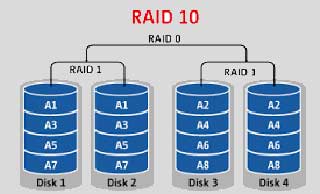 RAID stands for “Redundant Array of Independent Disks.” It refers to a method of storing information on multiple hard disks simultaneously for greater protection and drive performance. The RAID 10 setup is not typically used by the average user, instead being preferred by corporations running Enterprise-level servers. This configuration is necessary when you need extremely high redundancy, which is important when you’re supporting a server or a major database. RAID 10, or RAID 1+0 as it’s sometimes referred to, combines the “mirroring” of a RAID 1 configuration and the “striping” of a RAID 0 configuration. In the former, data is written to multiple hard disks simultaneously. In the latter, data is broken up into chunks and the chunks are written to different disks in succession. This combines the redundancy of mirroring with speed of access of a striping.
RAID stands for “Redundant Array of Independent Disks.” It refers to a method of storing information on multiple hard disks simultaneously for greater protection and drive performance. The RAID 10 setup is not typically used by the average user, instead being preferred by corporations running Enterprise-level servers. This configuration is necessary when you need extremely high redundancy, which is important when you’re supporting a server or a major database. RAID 10, or RAID 1+0 as it’s sometimes referred to, combines the “mirroring” of a RAID 1 configuration and the “striping” of a RAID 0 configuration. In the former, data is written to multiple hard disks simultaneously. In the latter, data is broken up into chunks and the chunks are written to different disks in succession. This combines the redundancy of mirroring with speed of access of a striping.
However, because of the complexity of a RAID 10 configuration, if your entire hard drive array does fail, recovering your data will be a trickier proposition. In this case, you might be better off hiring a RAID 10 data recovery service to do the job for you.
Hard Drive Recovery Group are your Data Recovery Medics. Their team of expert, highly trained engineers can recover data from failed, crashed, and broken RAID 10 servers no matter the cause. They have a Class 100 Clean Room, which means your drives will be worked on in a completely secure, sterile, dust free and static free environment with no chance of contamination. They have 24/7 emergency service, have the highest recovery percentages in the industry for RAID 10 failures, and their service comes with a unique guarantee: if they can’t recover all of your data, then you pay nothing.
Whether your RAID 10 failure is caused by fire, flood, or a power surge, Hard Drive Recovery Group can fix it. In fact, they are prepared for every conceivable cause of failure, including:
- Physical Failure
- Multiple drive failure
- RAID controller card
- Physical RAID failure
- Ram failure
- Failed motherboard
- Failed backplane
- Electrical failure
- Drives offline
- Bad Sectors
- Natural disasters
- Physical drive failure
- User Error
- Deleted data
- Reformatted array or drives
- Incorrect replacement of drives
- Accidental initialization
- Logical Failure
- Virus, Trojan or worm
- Directory structure damage
- Damaged files and folders
- Registry configuration
- RAID configuration problem
- OS corruption
They can work with any operating system, including:
 All Windows OS
All Windows OS- All Mac OS
- All Linux OS
- All Unix OS
- All Linux NAS devices
- Novell NetWare
- Novell Open Enterprise
- VMWare
Finally, they support just about every type of hard drive interface:
- SCSI
- iSCSI
- IDE/PATA
- SAS
- SATA
- eSATA
- USB
- Firewire
- Thunderbolt
- Fiber channel
Hard Drive R has received approval from just about every major hardware manufacturer, including Microsoft, Apple, HP, Dell, and Compaq. That means that if you use their service, your manufacturer’s warranty will not be voided. They offer a free consultation and have locations in all 50 states. They are HIPPA and PCI compliant. They can recover all file types, even proprietary ones, including: Office documents, spreadsheets, pictures, images, email, SQL, QuickBooks, Virtual machines, Peachtree, videos, CAD files, database files, and more. They can work on all media device types, including but not limited to: Desktop hard drives, laptop hard drives, external hard drives, all versions of RAID, flash, SSD, camera cards, CD, DVD and more.
If you’ve got a RAID 10 configuration setup, it probably means you’re a business owner with extremely critical data. Therefore, you should not spare any expense when choosing a reliable and professional data recovery service. Make sure you select a company that takes your data as seriously as you do. Choose Hard Drive Recovery Group and rest assured that your critical data will not be lost.
There are no comments yet.